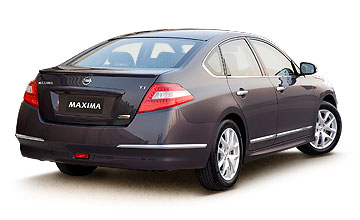BY BYRON MATHIOUDAKIS | 20th Apr 2009

Yes, reliable, comfortable, and – above all – satisfyingly powerful, for sure, but you would never drive this car for the same dynamic pleasures that similarly priced rivals such as a Ford Fairmont Ghia (let alone a BMW 3 Series) bestow.
So it is quite ironic that now, as the fifth Maxima for Australia is released (we got in on the act in 1990 when the third-generation model was introduced), Nissan has finally improved the steering and handling, just as it marches downmarket to take on the Toyota Camry and Aurion.
Undercutting even the cheapest BMW 118i, this BMW 5 Series-sized sedan is now the price of a BMW 0.5 Series.
And so, it is against the Toyota Camry Ateva, Honda Accord VTi or a Mazda6 that the new $33,990 2.5-litre V6-engined Maxima 250 ST-L must wage war.
Stylistically, we cannot imagine the under-50s really getting too rapt in this J32 series Maxima (the previous models’ buyer base were aged north of 55), but we do understand it.
Nissan’s global design boss asked GoAuto what we thought of the Maxima-previewing concept shown at the last Tokyo motor show back in 2007, and on hearing our reply of it being fussy and ‘Hyundai Grandeur-esque’, he was surprisingly un-catatonic, since succeeding in Asia is this latest Maxima’s aim after the last one languished for being perceived as too sober and “European.”
Well, we reckon the Maxima has the sort of presence that would leave many observers believing that its owner had bought a slightly upmarket Japanese car. Bling is clearly what Nissan believes this car’s global demographic desires, and – with its brash nose, striking alloys, showy chrome accents and (standard!) glitzy Xenon headlights and LED tail-lights – the Maxima delivers in spades.
Parked alongside a Camry or Honda Accord, it looks the much more expensive car, so that’s a result for Nissan.
It’s the same story inside. We loved the old J31 Maxima’s Northern European-like blonde wood inserts and clean, horizontal dash design, but it did feel a little cheap and cheerful to the touch.
Now we have a busy but touchy-feely set-up with leather on the wheel and seats of even the base model, classy instrumentation dials, ample room for five occupants, and the same Asian upmarket vehicle ambience as the exterior. ‘Infiniti-lite’ is how we’d put it. Prospective Aurion owners won’t know what hit them!
You know, Nissan is learning from its distant past as Datsun, because this is how the Japanese successfully infiltrated the Australian automotive consumer psyche in the 1960s and ‘70s – well-equipped and well-built cars for the money.
So how does a 1550kg-odd front-wheel drive Maxima with a 1000cc-smaller V6 engine than the old one go like?
As many of you would already know, the VQ series of Nissan V6s is a world-class engine, and even in its smaller-capacity iteration, this powerplant is a damn-sight sweeter than the big four-cylinder units that power the 250 ST-L Maxima’s opposition.
Mated to what must be the best CVT application we know of, the 2.5-litre V6 steps off from standstill in a brisk, melodic manner, and might even keep a driver guessing as to whether the engine really is the smaller of the two V6s on offer.
It is only when you need to accelerate at higher speeds that the sweet-revving 134kW/228Nm 250 ST-L betrays its capacity shortfall. But it never feels slow or undernourished. Nissan sure makes lovely V6s.
Earlier we touched on the improved handling, and – indeed – the Maxima finally feels more controlled when you tip it into a corner, with less roll and inertia for the driver to deal with.
And the steering feels more alive the faster you go, weighing up from the slightly dead-feel at low velocities, to a surprisingly sharp and responsive helm through the long and fast turns we weaved this through during the Victorian countryside launch drive.
Downsides were few, but we might want to drive this car on inner-urban roads before declaring the ride quality a total success. The same also goes for the Maxima’s steering and handling over such surfaces.
But, dynamically, it all is looking much more positive than we expected, frankly, after the shock of driving an Asian-market tuned Maxima prototype about a year ago. That felt as numb and sloppy as the Rococo styling suggests.
Nissan says the Aurion was one of the handling benchmarks used when engineers from Japan were out in Australia to sort the car, and it shows.
Moving on to the 185kW/326Nm 3.5-litre V6 350 ST-S and its chi-chi 350 Ti sibling, the drive feels virtually identical except that there is discernibly more performance available across the rev range, with the V6 working less hard to haul the Maxima around when the driver needs to make a couple of sudden manoeuvres.
The Ti’s interior also really benefits from the GPS screen in the dashboard, but otherwise the occupants are in for the same well-made, nicely insulated and comfortable experience as those in the base Maxima.
On the other hand, we were shocked that such a vehicle in 2009 lacks telescopic (reach) steering adjustment, while the archaic and annoying foot-operated park brake screams sock-hop, drive-in and McCarthyism era Americana!
We arrived at the J32 Maxima launch feeling sceptical that this car can make the sort of impact that its prettier predecessor(s) couldn’t, but have come away impressed with how much better overall the Nissan is to both drive and travel in.
Furthermore, we think that it deserves a big look-in if you are in the market for a large and extremely well equipped feel-good family sedan.
The latest Maxima may well be the best chance the model has in cracking the big time in two decades.